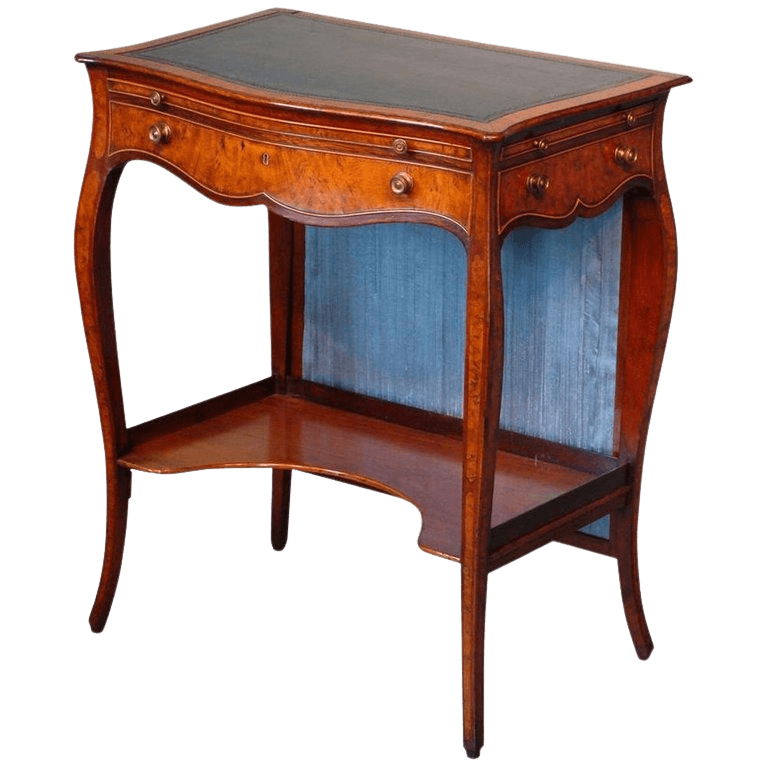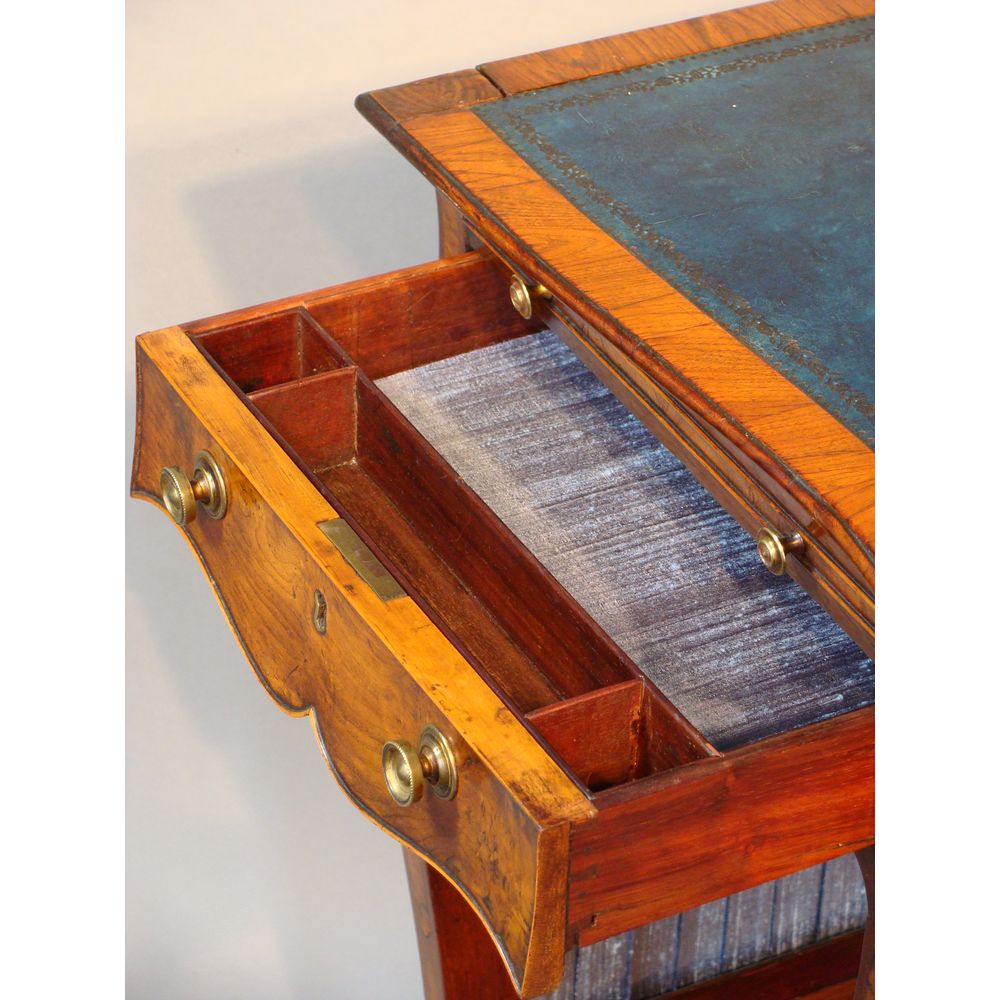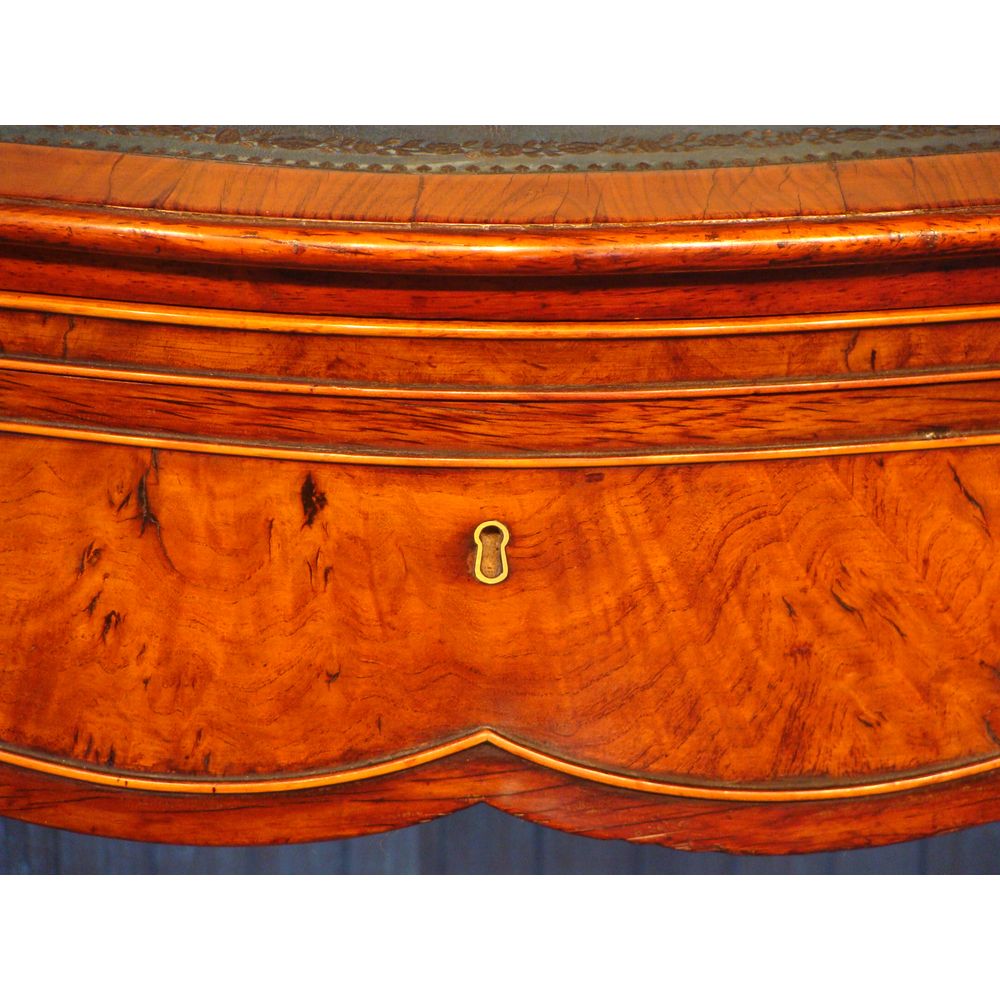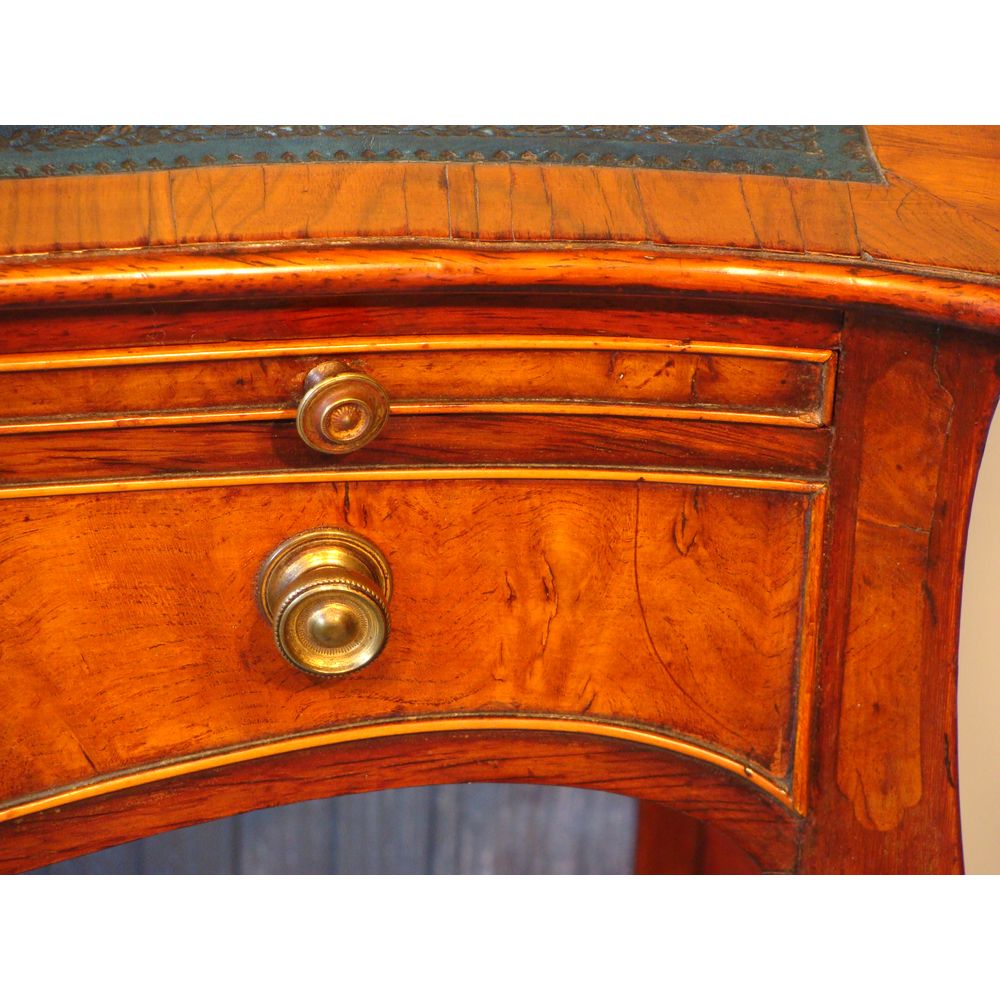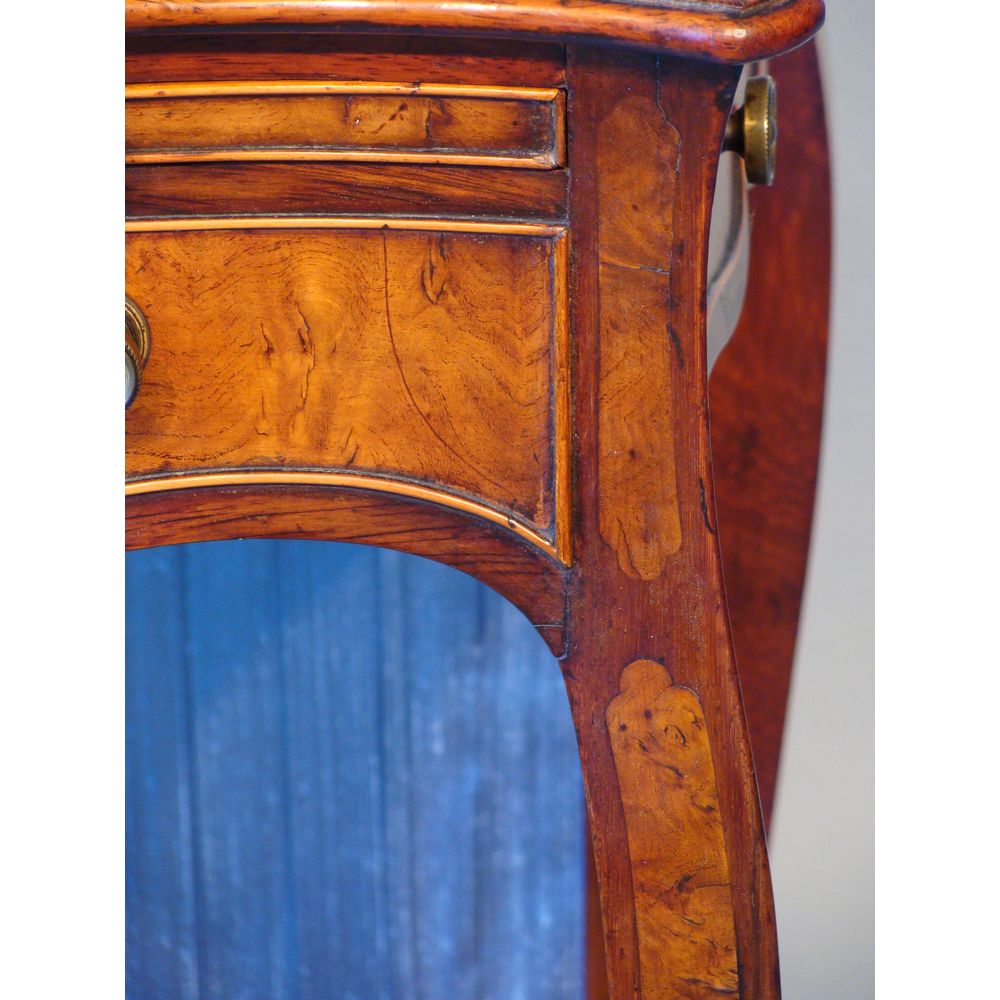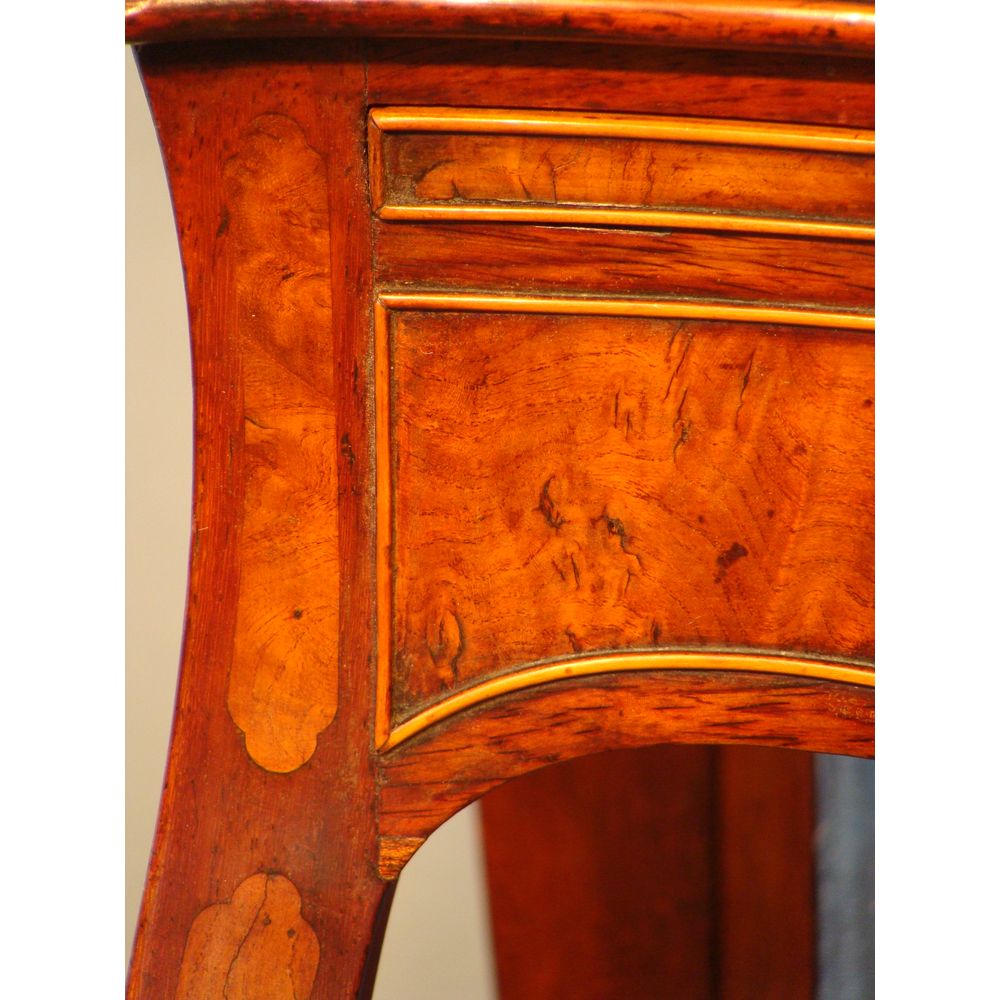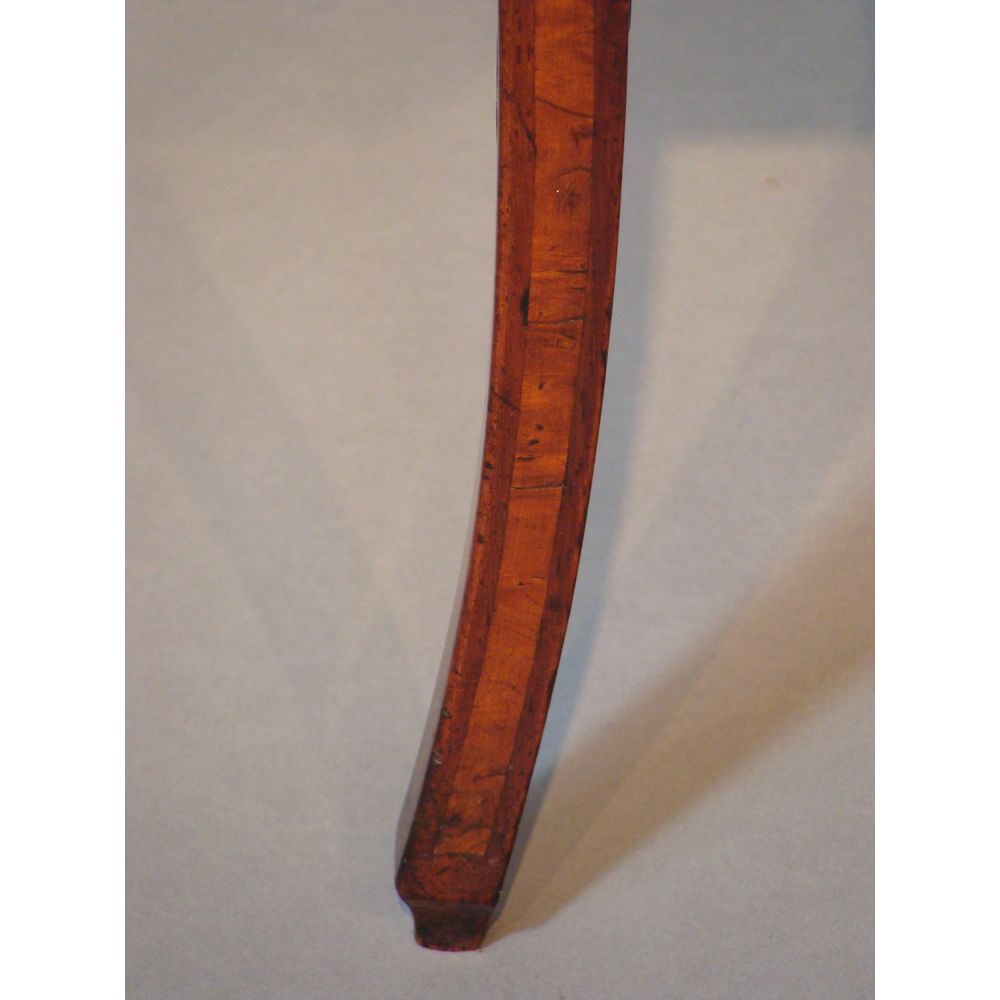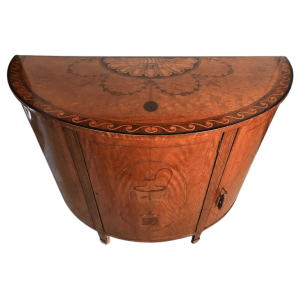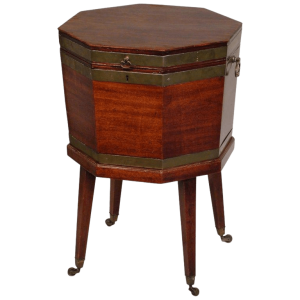Description
A fine George III-period sabicu and goncalo alves serpentine writing / dressing table. In the manner of master cabinet-maker Pierre Langlois. Circa 1770.
Of great colour, condition and surface patination.
The serpentine top inset with a blue, gilt-tooled leather writing surface. The frieze with one long silk-lined, side-fitted cockbeaded drawer below a simulated slide. The reverse simulated to match with a working slide to the front, also fitted with a blue tooled-leather writing surface. Raised on elegant slender cabriole legs in the French taste, with four sabicu-inlaid reserves, and united by a concave-fronted platform stretcher. The reverse with a rising slide fitted with a pleated blue silk panel. Apparently retaining its original brass mounts.
This lovely antique English table would make a useful small side table / lamp table / occasional table.
Measures: Height 29.5″ (75 cm) Width 25″ (63 cm) max Depth 17″ (43 cm).
A closely related writing table, lacking its screen, sold at Christies London 13th April, 1989, lot 68, for £7,700.00.
See a similar table sold in New York, 16th April 2002, lot 41, sale no. 1146, for £8,500.00.
A very similar table, but lacking its under tier, was sold in Christies, New York, 21 Oct 1999, lot 87, for $27,600. For further reading see below: This form of elegant ladies writing/ dressing table is based on mid-18th century French designs introduced by the eminent cabinet-maker Pierre Langlois (fl. 1759-1781) and illustrated on his trade card. Vis. V & A museum, London; collections.vam.ac.uk
A table of the same distinctive form is illustrated in L. Synge, The Mallett Millennium (Suffolk, 1999) p. 176, pl.21.
Langlois must have trained in one of the best Paris marquetry workshops, possibly that of Jean-Francois Oeben (1721-1763). Langlois shared his London premises in Tottenham Court Road with his son-in-law, the bronze caster and gilder Dominique Jean, who made the mounts for his furniture. Langlois’ London clients included John Russell, 4th Duke of Bedford (1710-1771), George William, 6th Earl of Coventry (1722-1809), and Horace Walpole. He sent furniture to Lady Louisa Connolly in Ireland at Castletown House, County Kildare, and to Elizabeth, Duchess of Northumberland, at Alnwick Castle, Northumberland. Langlois is known to have supplied a similar table to the Duchess of Northumberland in the early 1760’s. Lit: Cobb’s designs in the Royal Collection at Buckingham Palace. This table shows clear French influence adopted by both John Cobb and Thomas Chippendale. A similar table was supplied to Nostell Priory in 1766 for Sir Rowland Winn (d. 1785), and is illustrated in A. Coleridge’s ‘Chippendale Furniture’ (London, 1968) plate 354. www.nationaltrust.org.uk/nostell-priory
For further refs. to Langlois see P. Thornton & W. Rieder ‘Pierre Langlois Ebeniste’ Part 4 (The Connoisseur, April 1972) p. 258, fig. 4. Another eminent cabinet-maker associated with these fine tables is John Cobb (1710-1778) of St Martin’s Lane, London, (son-in-law of Giles Grendey). John Cobb syndicated in 1750 with William Vile. Vile and Cobb supplied furniture to the leading patrons of the day including George III and Queen Charlotte, the 1st Earl of Leicester at Holkham Hall, the 4th Duke of Devonshire at Chatsworth, and the 4th Duke of Bedford at Woburn Abbey. A table of very similar form, but in tulip and rosewood, was made for Nostell Priory, Yorkshire, and is illustrated in Christopher Gilbert’s, ‘The Life and Work of Thomas Chippendale’ (London, 1978) vol II, fig. 436.
For similarities in the treatment of the serpentine skirt, cockbeaded simulated drawers and delicately slender ‘French’ cabriole legs see Christie’s Catalogue of ‘The Samuel Messer Collection’ 5th December 1991, p. 153, lot 116, and lot 115, p. 152.
Ralph Edwards CBE FSA, in his Shorter Dictionary of English Furniture (Fourth edition 1972) illustrates on p. 611, fig. 5, a related ‘’Walnut Work Table on slender cabriole legs; screen pulls up; circa 1770 (Donaldson collection). Sheraton explains that “they are intended for a lady to write or work at near the fire, the screen part behind protecting the face”.
References:
Gonçalo alves is a hardwood (from the Portuguese name). It is sometimes referred to as zebrawood or tiger wood – names that underscore the wood’s often dramatic, contrasting color scheme, that some compare to rosewood. While the sapwood is very light in color, the heartwood is a sombre brown, with dark streaks that give it a unique look. The wood’s color deepens with prolonged exposure to light, and even the plainer looking wood has a natural lustre. Two species are usually listed as sources for gonçalo alves: astronium fraxinifolium and astronium graveolens, although other species in the genus may yield similar wood. The amount of striping that is present may vary. All trees grow in tropical forests. Brazil is a major exporter of these woods.
Sabicu is the timber of at least two species of the genus lysiloma. Lysiloma sabicu (L.) Benth. It occurs sparingly in the Bahamas, Jamaica, Haiti, The Dominican Republic, and Cuba. It was named by George Bentham (1800-1884) from a Cuban specimen examined in 1854. [1] Bentham went on to identify a second species, Lysiloma latisiliquum (L.) Benth., which grows best in the Bahamas.[2] The latter is commonly known as ‘wild tamarind’ or ‘false tamarind’. The wood of both species is similar, being mid-brown in color, sometimes with a reddish hue, heavy (specific gravity of 0.40-0.75)[3] hard and durable. Some timber is well figured, but most relatively plain.
The wood has been used in construction, shipbuilding and in furniture making, although its weight is a distinct drawback for the latter purpose. The stairs of The Crystal Palace London in which The Great Exhibition of 1851 was held, were made of sabicu due to its durability. Despite the enormous traffic that passed over them, the wood at the end was found to be little affected by wear. There is some confusion in the published literature between L. sabicu and L. latisiliquum, although there is little doubt that the former was the most important commercial species.[4] There is also confusion with other Bahamian species colloquially known as ‘tamarind’, several of which were also called sabicu. The most common of these are Peltophorum adnatum Griseb. And Cojoba arborea (L.) Britton & Rose. At various times their wood has also been called ‘horseflesh mahogany’. The Economic Botany collection at the Royal Botanic Gardens, Kew, London, contains specimens of wood from all these species collected at various times in the 19th and early 20th centuries. The labelling evinces considerable confusion, but it seems likely that ‘horseflesh mahogany’ properly applies to peltophorum and cojoba, while sabicu applies to lysiloma.



